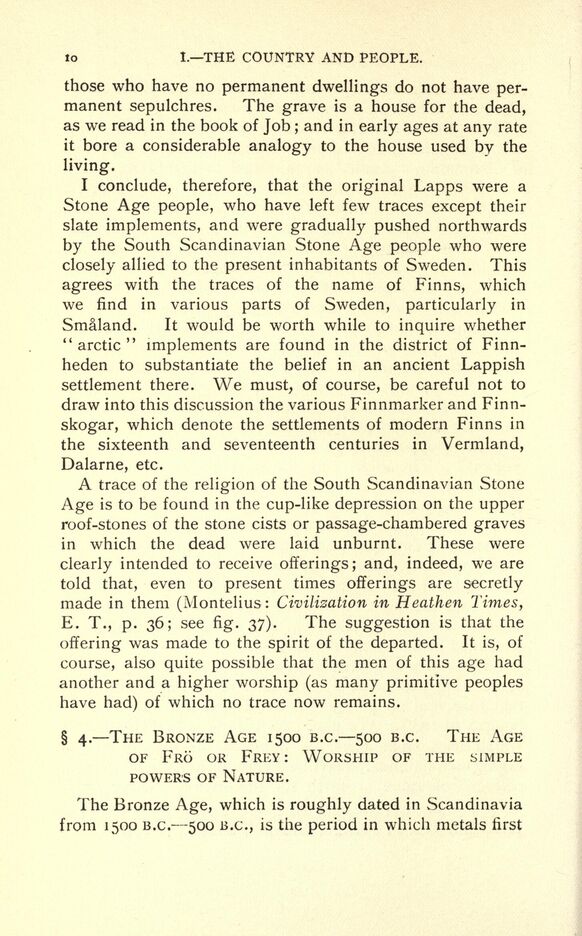
Full resolution (JPEG) - On this page / på denna sida - I. Introductory Lecture.—The Country and its Inhabitants in the Heathen Period up to 1000 A.D. - § 3. The Inhabitants—The Stone Age - § 4. The Bronze Age

<< prev. page << föreg. sida << >> nästa sida >> next page >>
Below is the raw OCR text
from the above scanned image.
Do you see an error? Proofread the page now!
Här nedan syns maskintolkade texten från faksimilbilden ovan.
Ser du något fel? Korrekturläs sidan nu!
This page has never been proofread. / Denna sida har aldrig korrekturlästs.
to I. THE COUNTRY AND PEOPLE.
those who have no permanent dwellings do not have per
manent sepulchres. The grave is a house for the dead,
as we read in the book of Job ;
and in early ages at any rate
it bore a considerable analogy to the house used by the
living.
I conclude, therefore, that the original Lapps were a
Stone Age people, who have left few traces except their
slate implements, and were gradually pushed northwards
by the South Scandinavian Stone Age people who were
closely allied to the present inhabitants of Sweden. This
agrees with the traces of the name of Finns, which
we find in various parts of Sweden, particularly in
Smaland. It would be worth while to inquire whether
"
arctic
"
implements are found in the district of Finn-
heden to substantiate the belief in an ancient Lappish
settlement there. We must, of course, be careful not to
draw into this discussion the various Finnmarker and Finn-
skogar, which denote the settlements of modern Finns in
the sixteenth and seventeenth centuries in Vermland,
Dalarne, etc.
A trace of the religion of the South Scandinavian Stone
Age is to be found in the cup-like depression on the upper
roof-stones of the stone cists or passage-chambered graves
in which the dead were laid unburnt. These were
clearly intended to receive offerings; and, indeed, we are
told that, even to present times offerings are secretly
made in them (Montelius : Civilization in Heathen Times,
E. T., p. 36; see fig. 37). The suggestion is that the
offering was made to the spirit of the departed. It is, of
course, also quite possible that the men of this age had
another and a higher worship (as many primitive peoples
have had) of which no trace now remains.
4. THE BRONZE AGE 1500 B.C. 500 B.C. THE AGE
OF FRO OR FREY : WORSHIP OF THE SIMPLE
POWERS OF NATURE.
The Bronze Age, which is roughly dated in Scandinavia
from 1500 B.C. 500 B.C., is the period in which metals first
<< prev. page << föreg. sida << >> nästa sida >> next page >>